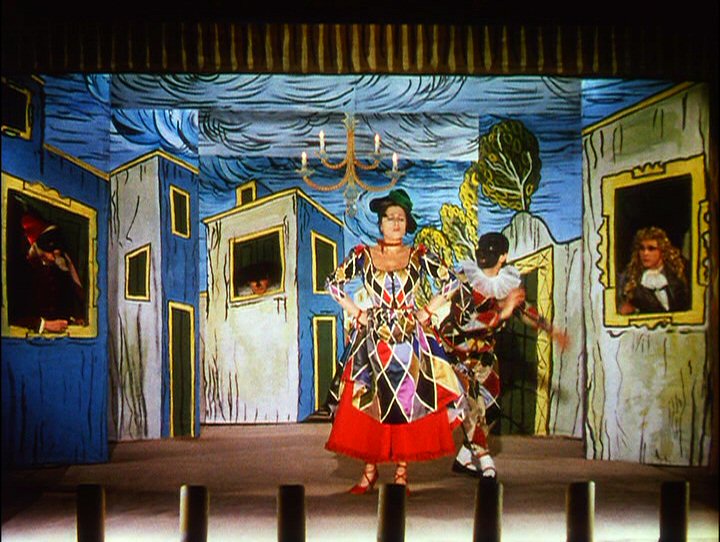
Another week, another Renoir. The Golden Coach this week – and once again, I’ve been caught by surprise. I really didn’t think that I’d particularly gel with his later work at all and hey presto, a week later and The River and The Golden Coach are battling it out for my #2 fave of his films. Well, actually I think the latter film has successfully taken up that position now. It forms such a marked contrast to its predecessor – whilst The River was serene and casual in its pacing and realistic in its form if not its content, The Golden Coach is a bold celebration of artifice (funny, considering the recent mini-discussion?) that flaunts its exuberant colour palette with the intent of explicitly captivating its audience – and Renoir once again proves himself to be a master in the art of cinematic seduction.
TGC terms itself as a “fantasy” from its opening intertitle, and from thereon it presents a thorough examination of the role of theatre and performance (read: artifice) in both the artistic and social worlds. The flamboyant colour scheme and decor forms just one aspect of this complex study: for example, Renoir repeatedly exposes the fact that the film takes place on giant sets and consequently breaks the fourth wall – thus causing a blurring of the distinctions between theatricality and reality (presuming that the latter even exists in the director’s cinematic world.) This then draws attention to the art of performing: and when dealing with the stars themselves, it’s apparent that Renoir was going for anything but realism. One could just accuse the actors of being flat-out bad, but this would be a discredit to the talents of both Anna Magnani and Renoir himself – who, on numerous occasions revealed his knack for directing English-language stars to great English-language performances and was far too brilliant a director to allow ‘bad’ acting infiltrate his film without good reason. The heightened theatricality of the performers at work here suggests that Renoir was further augmenting the general detachment from reality already communicated via the construct of the film itself, and taken in this context Magnani’s performance is a marvel to behold. Her grasp of English leaves much to be desired, but the gusto and sheer determination with which she attacks her role invites comparisons to the greatest star performances that Hollywood had to offer. Every imperfection is stubbornly battered into submission by Magnani’s ferocious brand of charm, a factor which much of TGC’s success hinges upon.
Much has been said about the evaporation during the 1950s of Renoir’s socio-political consciousness that permeated so much of his extraordinary 1930s output, and certainly upon first glance TGC does strike one as a ‘lighter’ effort from a director known as much for his vicious satirical streak as his compassionate humanism. Look a little closer however, and it’s easy to find traces of the badass Renoir of old. The art of performance is not just applicable to the actors, but also to the characters within the filmic world due to the enormous focus on roleplaying in the text. A notable chunk of the film’s allure is dependent upon the exaggerated farcical elements (influenced heavily by La Règle du jeu) that arises from this utilisation of acting-within-performance and which manifests itself in the form of that oh-so familiar concept of class tensions. This is most notable in the relationship shared by Camilla and the Viceroy of course, but consider also the strained liaisons between the Viceroy and his courtiers. Emblematic of these struggles is the ludicrous sequence involving the Viceroy’s attempts to juggle his allegiances between wife, noblemen and mistress (Camilla) each boxed into their own separate rooms: as avid a reflection of social constraints as ever there was in Renoir’s oeuvre, with the direst of political implications hinted at as a result – although admittedly, the critique of the political system’s hypocrisy is severely softened by the film’s situation in the historical past.
To all this, Renoir adds another – arguably more fulfilling – dimension with an investigation of artistic constraints. Thanks to the complex relations between financier, actor and audience there exists a visible contest to exert one’s authority in the precarious world of the performing arts. Camilla succeeds in achieving this, but at what cost? Assuming that the film isn’t simply an extended stage performance, Renoir raises the question of how far actors can act outside of their given roles (yes, it’s almost a Lynchian precursor!) The film’s most notable ‘weakness’ is in it’s failure to conjure up a romantic drama of any substance – despite having three male suitors to exploit. But this is perhaps less a fault and more an embracement of artificiality that finds resonance in the characterisations themselves (note how Ramon’s ‘love’ is a vanity project, whilst the Viceroy uses Camilla to distract from his own monotonous existence.) Camilla’s renunciation during the finale then, should be seen as inevitable: she makes a conscious decision to live her life through the prism of the “2 hours a day” that she spends on stage. This serves as a surprisingly bittersweet end to a film whose critiques are for the most part internalised: aside from dedicating herself wholly to her audience (i.e. us?) and rejecting the opulence of the ‘Golden Coach’ of the title, Camilla implies that any real world has failed to fulfil her wants and needs. In essence, she actively chooses the creative (artificial?) world over the everyday reality of life, realising that love is simply not enough. Maybe, just maybe, we could stretch this analogy to Renoir himself?
No comments:
Post a Comment